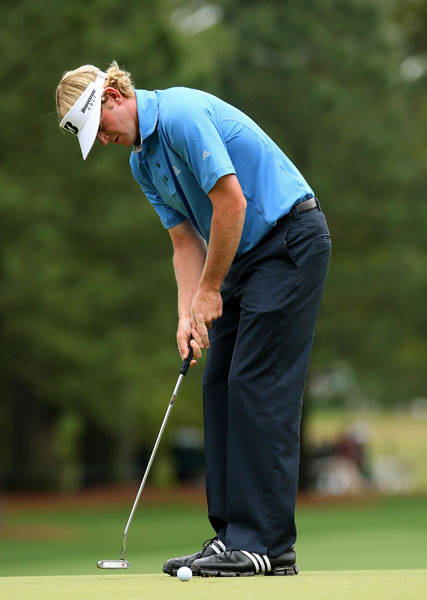PGA Tour adds new Putting Stat
/ This week the PGA Tour adds a new stat Strokes Gained - Putting. The number-crunchers at the Tour say the reason is simple -- Strokes Gained-Putting takes out the bias of the old stats. The new statistic isn't impacted by what you did to get to the green; it only reflects what you did (against what your opponents did) once you got there. I love the idea. Similar to the ideas used in Michael Lewis' Moneyball (about baseball statistics) what truly goes into each statistics is being brought into question and as a result, being understood that much better.
This week the PGA Tour adds a new stat Strokes Gained - Putting. The number-crunchers at the Tour say the reason is simple -- Strokes Gained-Putting takes out the bias of the old stats. The new statistic isn't impacted by what you did to get to the green; it only reflects what you did (against what your opponents did) once you got there. I love the idea. Similar to the ideas used in Michael Lewis' Moneyball (about baseball statistics) what truly goes into each statistics is being brought into question and as a result, being understood that much better.
Initially developed by Professor Mark Broadie of Columbia Business School and further analyzed in collaboration with a team from Massachusetts Institute of Technology led by Professor Stephen Graves, Strokes Gained-Putting measures a player's putting performance relative to his fellow competitors in a tournament and will offer a more accurate portrayal of his overall putting performance.
Strokes Gained-Putting takes into account putting proficiency from various distances and computes the difference between a player's performance on every green -- the number of strokes needed to hole out -- against the performance of the other players for each round. This ultimately shows how many strokes are gained or lost due to putting for a particular round, for a tournament and over the course of a year.
Steve Evans from the PGA Tour called the new stat an "evolution in the way we understand the game." Brad Faxon, long known as one of the Tour's best putters, said the statistic "moves us well beyond where we have been in the past in our ability to measure, teach and explain putting performance."
Here's how the new statistic is computed:
For example, the average number of putts used to hole out from 7 feet, 10 inches is 1.5. If a player one-putts from this distance, he gains 0.5 strokes (1.5 - 1). If he two-putts, he loses 0.5 strokes (1.5 - 2). If he three-putts, he loses 1.5 strokes (1.5 - 3).
For the final statistic, a player's strokes gained or lost putting is compared to the field. For example, if a player gained a total of three strokes over the course of a round and the field gained an average of one stroke, the player's "Strokes Gained Against the Field" would be two.
Here are a few interesting points:
- The top 5 putters for 2011 using the new stat are Merrick, Chalmers, Snedeker, Stricker and Glover. If all the players in the field hit the ball the same this group would finish a combined 19.44 strokes ahead of average.
- The bottom 5 putters for 2011 are Cejka, Trahan, Slocum, Weekley and Els. They would finish 21.608 strokes behind average and lose to the lead group by more than a whopping 41 strokes! That requires a tremendous amount of great ball striking in order to compete.
- The Tour's most average putter is Harrison Frazar.
- The best handful of putters over the last few years (2004-present) on the PGA Tour have been: Tiger Woods; Brad Faxon; Luke Donald; Aaron Baddeley; Greg Chalmers; Steve Stricker; Brandt Snedeker; Ben Crane and Brian Gay. So these are the guys to imitate....
- Less than 6 percent of putts are made from more than 25 feet.
See the complete list of players from 2011
Here are a few "baseline" points against which the golfers will be measured:
- A player's chance of one-putting drops 20 percent when moving from 3 feet back to 5 feet.
- Just under 8 feet: At the 7-foot, 10-inch mark, it's 50/50 whether players will one or two putt.
- Players have a 1 in 3 chance of one-putting from 11 feet (34 percent).
- Players have a 3 in 4 chance of two-putt or better from 14 feet (75 percent).
- Players have a 1 in 10 chance of one-putting from 25 feet (10 percent).
- 33 feet is the point at which a player is expected to two-putt. This is interesting because while there is an 88 percent chance of a two-putt from this distance, it is the point at which a player is equally likely to one-putt or three-putt (6 percent each way).
- Players have a 1 in 10 chance of three-putting from 40 feet (10 percent).
- Players have a 1 in 3 chance of three-putting from 73 feet (33 percent).
- It is estimated that a players chances of a three-putt are not 50/50 until 120 feet. In general, greens on the PGA Tour are not large enough to provide a player with a 50/50 chance of three-putting.
Thanks to some very smart people and the PGA Tour, we now have a statistic that truly does measure putting prowess. Let the games begin.....








